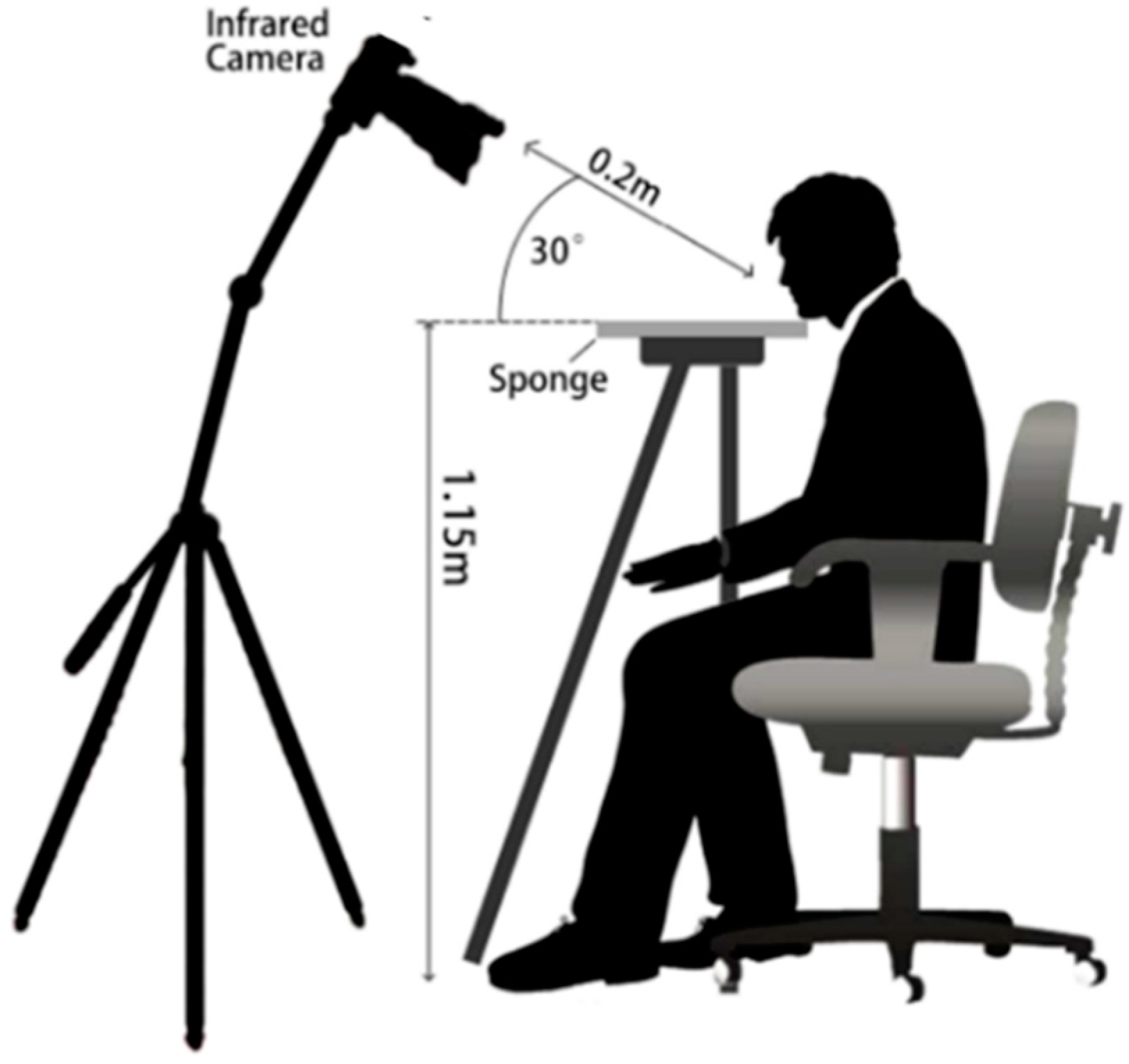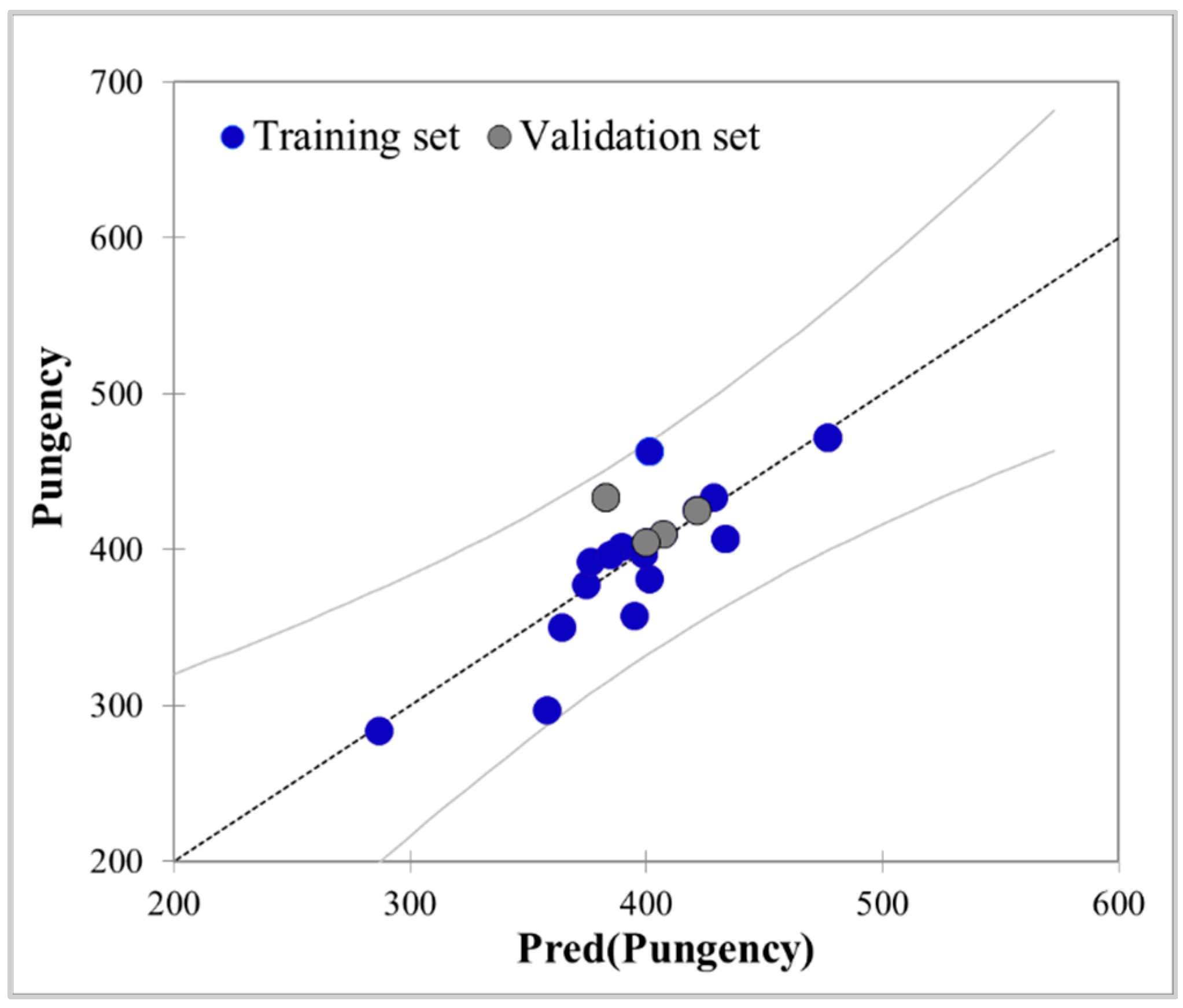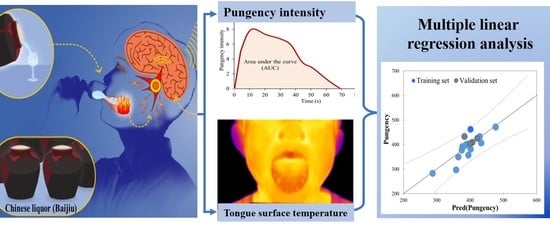A Novel Quantitative Prediction Approach for Pungency Level of Chinese Liquor (Baijiu) Based on Infrared Thermal Imager
Abstract
:1. Introduction
2. Materials and Methods
2.1. Materials and Samples
2.2. Establishing Infrared Thermal (IRT) Imaging Method for Tongue Surface Temperature Measurements
2.2.1. Participants
2.2.2. Infrared Thermal (IRT) Imager
2.2.3. IRT Image Acquisition
2.2.4. IRT Image Processing
2.3. Validating the Feasibility of Infrared Thermal (IRT) Imaging Method for Tongue Surface Temperature Measurements
2.3.1. Validating the Stability of Infrared Thermal Imaging (IRT) Method
2.3.2. Stimuli Application
2.4. Application of Infrared Thermal (IRT) Imaging Method for Quantitative Predicting Baijiu Pungency
2.4.1. Tongue Surface Temperatures after Baijiu Application
2.4.2. Time-Intensity (TI) Analysis for Pungency Intensity
2.5. Data Analysis
3. Results and Discussion
3.1. Validating the Stability of the Infrared Thermal (IRT) Imaging Method
3.2. Tongue Surface Temperatures after Stimuli Application
3.3. Relationship between Tongue Surface Temperatures and Pungency Intensity
4. Conclusions
Supplementary Materials
Author Contributions
Funding
Institutional Review Board Statement
Informed Consent Statement
Data Availability Statement
Acknowledgments
Conflicts of Interest
References
- Roque, J.; Auvray, M.; Lafraire, J. Understanding freshness perception from the cognitive mechanisms of flavor: The case of beverages. Front. Psychol. 2017, 8, 2360. [Google Scholar] [CrossRef] [PubMed] [Green Version]
- Kokkinidou, S.; Peterson, D.G. Identification of compounds that contribute to trigeminal burn in aqueous ethanol solutions. Food Chem. 2016, 211, 757–762. [Google Scholar] [CrossRef]
- Cravero, M.C.; Laureati, M.; Spinelli, S.; Bonello, F.; Monteleone, E.; Proserpio, C.; Lottero, M.R.; Pagliarini, E.; Dinnella, C. Profiling individual differences in alcoholic beverage preference and consumption: New insights from a large-scale study. Foods 2020, 9, 1131. [Google Scholar] [CrossRef]
- Rota, M.B.; Piggott, J.R.; Faria, J.B. Sensory profile and acceptability of traditional and double-distilled cachaca aged in oak casks. J. Inst. Brew. 2013, 119, 251–257. [Google Scholar] [CrossRef]
- Ickes, C.M.; Cadwallader, K.R. Characterization of sensory differences in mixing and premium rums through the use of descriptive sensory analysis. J. Food Sci. 2017, 82, 2679–2689. [Google Scholar] [CrossRef]
- Ickes, C.M.; Cadwallader, K.R. Effect of ethanol on flavor perception of Rum. Food Sci. Nutr. 2018, 6, 912–924. [Google Scholar] [CrossRef] [Green Version]
- Nose, A.; Murata, T.; Hamakawa, Y.; Shoji, H.; Kozaki, D.; Hojo, M. Effects of solutes on the alcohol-stimulative taste of vodkas. Food Chem. 2021, 340, 128160. [Google Scholar] [CrossRef] [PubMed]
- Prescott, J.; Stevenson, R.J. Pungency in food perception and preference. Food Rev. Int. 1995, 11, 665–698. [Google Scholar] [CrossRef]
- Regueiro, J.; Negreira, N.; Simal-Gandara, J. Challenges in relating concentrations of aromas and tastes with flavor features of foods. Crit. Rev. Food Sci. Nutr. 2017, 57, 2112–2127. [Google Scholar] [CrossRef] [PubMed]
- Jin, G.Y.; Zhu, Y.; Xu, Y. Mystery behind Chinese liquor fermentation. Trends Food Sci. Technol. 2017, 63, 18–28. [Google Scholar] [CrossRef]
- Yang, F.; Zheng, J. Understand spiciness: Mechanism of TRPV1 channel activation by capsaicin. Protein Cell 2017, 8, 169–177. [Google Scholar] [CrossRef] [Green Version]
- Donnerer, J.; Lembeck, F. Heat loss reaction to capsaicin through a peripheral site of action. Br. J. Pharmacol. 1983, 79, 719–723. [Google Scholar] [CrossRef] [PubMed] [Green Version]
- Boudreau, S.A.; Wang, K.L.; Svensson, P.; Sessle, B.J.; Arendt-Nielsen, L. Vascular and psychophysical effects of topical Capsaicin application to orofacial tissues. J. Orofac. Pain 2009, 23, 253–264. [Google Scholar]
- Tansey, E.A.; Johnson, C.D. Recent advances in thermoregulation. Adv. Physiol. Educ. 2015, 39, 139–148. [Google Scholar] [CrossRef]
- Wu, Y.; Nieuwenhoff, M.D.; Huygen, F.J.; van der Helm, F.C.; Niehof, S.; Schouten, A.C. Characterizing human skin blood flow regulation in response to different local skin temperature perturbations. Microvasc. Res. 2017, 111, 96–102. [Google Scholar] [CrossRef]
- Xie, H.W.; Zhang, Y. Relationship between dynamic infrared thermal images and blood perfusion rate of the tongue in anaemia patients. Infrared Phys. Technol. 2018, 89, 27–34. [Google Scholar] [CrossRef]
- Bouzida, N.; Bendada, A.; Maldague, X.P. Visualization of body thermoregulation by infrared imaging. J. Therm. Biol. 2009, 34, 120–126. [Google Scholar] [CrossRef]
- Thomas, A.N.; Larissa Bittencourt da, S.; Lars, A.-N.; Parisa, G. The effect of topical capsaicin-induced sensitization on heat-evoked cutaneous vasomotor responses. Int. J. Physiol. Pathophysiol. Pharmacol. 2013, 5, 148–160. [Google Scholar]
- Lv, C.; Wang, X.M.; Chen, J.S.; Yang, N.; Fisk, L. A non-invasive measurement of tongue surface temperature. Food Res. Int. 2019, 116, 499–507. [Google Scholar] [CrossRef] [PubMed]
- Ring, E.F.; Ammer, K. Infrared thermal imaging in medicine. Physiol. Meas. 2012, 33, R33–R46. [Google Scholar] [CrossRef]
- Khan Raja, B.N.; Miramini, S.; Duffield, C.; Sofi, M.; Mendis, P.; Zhang, L.H. The influence of ambient environmental conditions in detecting bridge concrete deck delamination using infrared thermography (IRT). Struct. Control. Health Monit. 2020, 27, e2506. [Google Scholar] [CrossRef]
- Noufid, A.; Belattar, S. Simulation of a defect in a concrete dam structure using steady-state infrared thermography. Iran. J. Sci. Technol. Trans. Civ. Eng. 2020, 45, 187–196. [Google Scholar] [CrossRef]
- Ring, E.F.J. The historical development of temperature measurement in medicine. Infrared Phys. Technol. 2007, 49, 297–301. [Google Scholar] [CrossRef]
- Mi, B.H.; Song, J.L.; Hong, W.X.; Zhang, W.Z.; Wang, Y. Evaluation method of infrared thermography on children with idiopathic thrombocytopenic purpura: Preliminary. Infrared Phys. Technol. 2019, 102, 103027. [Google Scholar] [CrossRef]
- Zhang, L.; Guo, H.J.; Li, Z.B. Application of medical infrared thermal imaging in the diagnosis of human internal focus. Infrared Phys. Technol. 2019, 101, 127–132. [Google Scholar] [CrossRef]
- He, Y.; Liu, Z.; Qian, M.; Yu, X.; Xu, Y.; Chen, S. Unraveling the chemosensory characteristics of strong-aroma type Baijiu from different regions using comprehensive two-dimensional gas chromatography-time-of-flight mass spectrometry and descriptive sensory analysis. Food Chem. 2020, 331, 127335. [Google Scholar] [CrossRef]
- ASTM E1909-13 Standard Guide for Time-Intensity Evaluation of Sensory Attributes; ASTM International: West Conshohocken, PA, USA, 2017.
- Goodstein, E.S.; Bohlscheid, J.C.; Evans, M.; Ross, C.F. Perception of flavor finish in model white wine: A time-intensity study. Food Qual. Prefer. 2014, 36, 50–60. [Google Scholar] [CrossRef]
- Pinheiro, A.C.M.; Nunes, C.A.; Vietoris, V. SensoMaker: A tool for sensorial characterization of food products. Cienc. E Agrotecnologia 2013, 37, 199–201. [Google Scholar] [CrossRef] [Green Version]
- Zhang, Y.C.; Chen, Y.M.; Luo, C. A method for improving temperature measurement precision on the uncooled infrared thermal imager. Measurement 2015, 74, 64–69. [Google Scholar] [CrossRef]
- Zhang, Y.C.; Chen, Y.M.; Fu, X.B.; Luo, C. A method for reducing the influence of measuring distance on infrared thermal imager temperature measurement accuracy. Appl. Therm. Eng. 2016, 100, 1095–1101. [Google Scholar] [CrossRef]
- Zhang, Y.C.; Wang, Z.K.; Fu, X.B.; Yan, F.; Kong, T. An experimental method for improving temperature measurement accuracy of infrared thermal imager. Infrared Phys. Technol. 2019, 102, 103020. [Google Scholar] [CrossRef]
- Schaefer, A.L.; Cook, N.J.; Bench, C.; Chabot, J.B.; Colyn, J.; Liu, T.; Okine, E.K.; Stewart, M.; Webster, J.R. The non-invasive and automated detection of bovine respiratory disease onset in receiver calves using infrared thermography. Res. Vet. Sci. 2012, 93, 928–935. [Google Scholar] [CrossRef] [PubMed]
- Mccafferty, D.J. The value of infrared thermography for research on mammals: Previous applications and future directions. Mammal. Rev. 2007, 37, 207–223. [Google Scholar] [CrossRef]
- Church, J.S.; Hegadoren, P.R.; Paetkau, M.J.; Miller, C.C.; Regev-Shoshani, G.; Schaefer, A.L.; Schwartzkopf-Genswein, K.S. Influence of environmental factors on infrared eye temperature measurements in cattle. Res. Vet. Sci. 2014, 96, 220–226. [Google Scholar] [CrossRef] [PubMed]
- Trevisani, M.; Siemens, J.; Materazzi, S.; Bautista, D.M.; Nassini, R.; Campi, B.; Imamachi, N.; Andre, E.; Patacchini, R.; Cottrell, G.S.; et al. 4-Hydroxynonenal, an endogenous aldehyde, causes pain and neurogenic inflammation through activation of the irritant receptor TRPA1. Proc. Natl. Acad. Sci. USA 2007, 104, 13519–13524. [Google Scholar] [CrossRef] [PubMed] [Green Version]
- Bang, S.; Kim, K.Y.; Yoo, S.; Kim, Y.G.; Hwang, S.W. Transient receptor potential A1 mediates acetaldehyde-evoked pain sensation. Eur. J. Neurosci. 2007, 26, 2516–2523. [Google Scholar] [CrossRef] [PubMed]
- Song, X.; Zhu, L.; Wang, X.; Zheng, F.; Zhao, M.; Liu, Y.; Li, H.; Zhang, F.; Zhang, Y.; Chen, F. Characterization of key aroma-active sulfur-containing compounds in Chinese Laobaigan Baijiu by gas chromatography-olfactometry and comprehensive two-dimensional gas chromatography coupled with sulfur chemiluminescence detection. Food Chem. 2019, 297, 124959. [Google Scholar] [CrossRef]
- Macpherson, L.J.; Geierstanger, B.H.; Viswanath, V.; Bandell, M.; Eid, S.R.; Hwang, S.; Patapoutian, A. The pungency of garlic: Activation of TRPA1 and TRPV1 in response to allicin. Curr. Biol. 2005, 15, 929–934. [Google Scholar] [CrossRef] [Green Version]
- Zhang, L.L.; Xu, S.S.; Shi, B.L.; Wang, H.Y.; Liu, L.Y.; Zhong, K.; Zhao, L.; Chen, Z.X. Evaluation of the pungency intensity and time-related aspects of Chinese Zanthoxylum bungeanum based on human sensation. J. Sens. Stud. 2018, 33, e12465. [Google Scholar] [CrossRef]
- Vidal, L.; Antunez, L.; Gimenez, A.; Medina, K.; Boido, E.; Ares, G. Dynamic characterization of red wine astringency: Case study with Uruguayan Tannat wines. Food Res. Int. 2016, 82, 128–135. [Google Scholar] [CrossRef]
- Eib, S.; Schneider, D.J.; Hensel, O.; Seuß-Baum, I. Evaluation of trigeminal pungency perception of allyl isothiocyanate—A time intensity (TI) study. Food Qual. Prefer. 2021, 87, 104039. [Google Scholar] [CrossRef]
- Blanco, I.; Schettini, E.; Vox, G. Predictive model of surface temperature difference between green façades and uncovered wall in Mediterranean climatic area. Appl. Therm. Eng. 2019, 163, 114406. [Google Scholar] [CrossRef]
- Dialamehpour, F.; Shafiei, F. Quantitative structure–property relationship models to predict thermodynamic properties of some mono and polycyclic aromatic hydrocarbons using genetic algorithm-multiple linear regression. J. Chin. Chem. Soc. 2019, 67, 969–982. [Google Scholar] [CrossRef]
- Dunkel, A.; Hofmann, T. Carbonic anhydrase IV mediates the fizz of carbonated beverages. Angew. Chem. 2010, 49, 2975–2977. [Google Scholar] [CrossRef] [PubMed]
- Carstens, E.; Carstens, M.I.; Dessirier, J.M.; O’Mahony, M.; Simons, C.T.; Sudo, M.; Sudo, S. It hurts so good: Oral irritation by spices and carbonated drinks and the underlying neural mechanisms. Food Qual. Prefer. 2002, 13, 431–443. [Google Scholar] [CrossRef]
- McMahon, K.M.; Culver, C.; Castura, J.C.; Ross, C.F. Perception of carbonation in sparkling wines using descriptive analysis (DA) and temporal check-all-that-apply (TCATA). Food Qual. Prefer. 2017, 59, 14–26. [Google Scholar] [CrossRef]
- McMahon, K.M.; Culver, C.; Ross, C.F. The production and consumer perception of sparkling wines of different carbonation levels. J. Wine Res. 2017, 28, 123–134. [Google Scholar] [CrossRef]




| Test Day | ROI 1 | ROI 2 | ||||
|---|---|---|---|---|---|---|
| Min | Max | Aver | Min | Max | Aver | |
| Day 1 | 32.60 ± 0.73 | 36.43 ± 0.42 | 34.70 ± 0.37 | 33.80 ± 0.65 | 36.16 ± 0.55 | 35.04 ± 0.53 |
| Day 2 | 32.30 ± 0.57 | 36.27 ± 0.84 | 34.24 ± 0.72 | 33.47 ± 0.80 | 35.90 ± 0.75 | 34.70 ± 0.69 |
| Day 3 | 32.11 ± 0.70 | 36.23 ± 0.72 | 34.21 ± 0.46 | 33.26 ± 0.59 | 35.99 ± 0.68 | 34.73 ± 0.48 |
| p Value | 0.311 | 0.803 | 0.120 | 0.259 | 0.712 | 0.132 |
| Sample | ROI 1 | ROI 2 | ||||
|---|---|---|---|---|---|---|
| Min | Max | Aver | Min | Max | Aver | |
| Water | 31.86 ± 0.54 | 35.51 ± 0.76 | 33.77 ± 0.54 | 33.11 ± 0.48 | 35.39 ± 0.71 | 34.19 ± 0.55 |
| Baijiu | 32.41 ± 0.60 | 36.57 ± 0.58 | 34.54 ± 0.40 | 33.77 ± 0.54 | 36.13 ± 0.51 | 34.84 ± 0.34 |
| p Value | 0.094 | 0.013 | 0.011 | 0.033 | 0.043 | 0.02 |
| Aqueous Ethanol Solutions | ROI 1 | ROI 2 | ||||
|---|---|---|---|---|---|---|
| Min | Max | Aver | Min | Max | Aver | |
| 10% | 28.87 ± 1.96 | 35.47 ± 1.01 | 32.53 ± 0.93 | 31.57 ± 0.65 | 34.87 ± 1.31 | 32.83 ± 0.90 |
| 20% | 30.07 ± 1.19 | 35.80 ± 1.50 | 33.20 ± 1.50 | 32.13 ± 1.35 | 35.33 ± 1.08 | 33.47 ± 1.11 |
| 30% | 30.23 ± 1.59 | 36.17 ± 1.32 | 33.53 ± 1.36 | 32.50 ± 1.18 | 35.67 ± 1.33 | 34.03 ± 1.15 |
| 40% | 30.67 ± 0.45 | 35.47 ± 0.47 | 33.67 ± 0.91 | 32.03 ± 0.67 | 35.07 ± 0.15 | 34.27 ± 1.12 |
| 50% | 31.37 ± 1.50 | 36.60 ± 1.25 | 34.33 ± 1.46 | 33.33 ± 1.53 | 36.17 ± 1.08 | 34.63 ± 1.33 |
| Samples | ROI 1 | ROI 2 | ||||
|---|---|---|---|---|---|---|
| Min | Max | Aver | Min | Max | Aver | |
| 46% YCS | 31.95 ± 0.94 | 35.85 ± 0.62 | 33.91 ± 0.66 | 33.00 ± 0.88 | 35.65 ± 0.48 | 34.33 ± 0.52 |
| Old Baijiu | 32.21 ± 0.58 | 36.21 ± 0.59 | 34.36 ± 0.50 | 33.26 ± 0.81 | 35.98 ± 0.30 | 34.71 ± 0.57 |
| Young Baijiu | 32.44 ± 0.74 | 36.38 ± 0.74 | 34.74 ± 0.55 | 33.51 ± 0.87 | 36.14 ± 0.60 | 35.04 ± 0.44 |
| p Value | 0.461 | 0.280 | 0.031 | 0.497 | 0.137 | 0.037 |
Publisher’s Note: MDPI stays neutral with regard to jurisdictional claims in published maps and institutional affiliations. |
© 2021 by the authors. Licensee MDPI, Basel, Switzerland. This article is an open access article distributed under the terms and conditions of the Creative Commons Attribution (CC BY) license (https://creativecommons.org/licenses/by/4.0/).
Share and Cite
He, Y.; Chen, S.; Tang, K.; Xu, Y.; Yu, X. A Novel Quantitative Prediction Approach for Pungency Level of Chinese Liquor (Baijiu) Based on Infrared Thermal Imager. Foods 2021, 10, 1107. https://doi.org/10.3390/foods10051107
He Y, Chen S, Tang K, Xu Y, Yu X. A Novel Quantitative Prediction Approach for Pungency Level of Chinese Liquor (Baijiu) Based on Infrared Thermal Imager. Foods. 2021; 10(5):1107. https://doi.org/10.3390/foods10051107
Chicago/Turabian StyleHe, Yingxia, Shuang Chen, Ke Tang, Yan Xu, and Xiaowei Yu. 2021. "A Novel Quantitative Prediction Approach for Pungency Level of Chinese Liquor (Baijiu) Based on Infrared Thermal Imager" Foods 10, no. 5: 1107. https://doi.org/10.3390/foods10051107
APA StyleHe, Y., Chen, S., Tang, K., Xu, Y., & Yu, X. (2021). A Novel Quantitative Prediction Approach for Pungency Level of Chinese Liquor (Baijiu) Based on Infrared Thermal Imager. Foods, 10(5), 1107. https://doi.org/10.3390/foods10051107








